PLACES
OF
INTEREST
The Sultan’s Palace
Kraton Ngayogyakarta Hadiningrat, the Sultan;s Palace, is located at the southern end of Jalan Ahmad Yani. The Kraton is the heart of the city of Yogya and covers an area of one square kilometre surrounded by a wall. It is in a sense a city within the city, housing some 25,000 residents, many of them artisans producing traditional crafts like batik cloth, silver wares, wayang puppets and masks. Construction of the complex began in 1755, following yhe division of the kingdom of Mataram, and continued for nearly forty years. The innermost group of buildings, known as Proboyekso, is still the private residence of the reigning Sultan and this family. Here are kept many ancient pusaka, or sacred heirlooms. He reception hall, Bangsal Kencana, is a beautiful structure displaying exquisitely carved teak pillars and painted rafters. Itt was completed in 1792. A small museum exhibits some of the palace treasures, including gifts from European monarchs. Outside, in the Sri Manganti courtyard, two pendopo, traditional Javanese open sided buildings, contain four sets of gamelan instruments dating back to the 14th and 15th centuries. Also on view are gilded palanquins and sedan chairs, as well as an ancient bedug, the drum used to call Muslims to prayer.
Onthe northern and southern sides of the main palace buildings are large grassy areas known as Alun-Alun. In the middle of each stand two banyan trees, which are said to ‘guard’ the Kraton. Today, much of the Kraton is open to the republic and on Sunday’s visitors have the opportunity to watch classical dance rehearsals there.
Built in 18758 as a recreation area for Yogyakarta’s royal family, the ‘Water Castel’ of Tamansari lies a little to the south west of the Kraton. Although mostly in ruins, brought about by time, neglect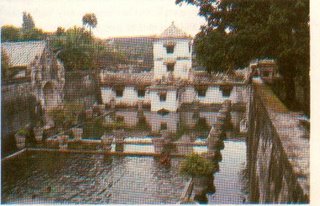 and an earthquake in 1867, Tamansari is still an anteresting place to see. Visitors can walk through a maze of underground passageways leading down to dark and mysterious rooms, long since desrted. Two large bathing pools, apparently used by princesses from the palace, are still visible but no longer in use.
and an earthquake in 1867, Tamansari is still an anteresting place to see. Visitors can walk through a maze of underground passageways leading down to dark and mysterious rooms, long since desrted. Two large bathing pools, apparently used by princesses from the palace, are still visible but no longer in use.
Tamansari once had two long tunnels, one of which was connected to the Kraton, the other surfacing some distance outside the city, some say as far away as Parangtritis. This second one wasbuilt as an escape route in the event of danger. Today, many batik artists live along Tamansari’s narrow pathways.
Mesjid Agung (The Great Mosque)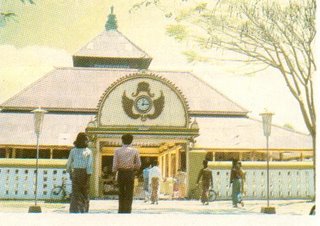
Lying on the western side of the northern Alun-Alun is the Great Mosque. The building was designed by the court architect Wiryokusumo on the order of Sultan Hamengku Buwono I ang completed on 29th May 1773. Two plaques, inscribed in Arabic and Javanese, are displayed on the walls ot the Mosque and mark the date of it’s completion.
The Bird Market is located near the ruins of Tamansari. Rows of brightly coloured cages contain a large variety of birds from all oer Indonesia, as well as rabbits, kittens, guinea pigs and the occasional fruit bat. Many people come here to find rare songbirds, which are entered into competitions and commad very hidh prices. Visitors may be surprised to see some of the caged bird set high up on poles. The reson for this is that the birds are said to sing better in this position.
Jalan Malioboro
Malioboro is the most famous street in Yogyakarta. It runs north-south from the main rail wal station towards the Kraton. Derived from the word Marlborough, the name of the street traces it’s origins back to th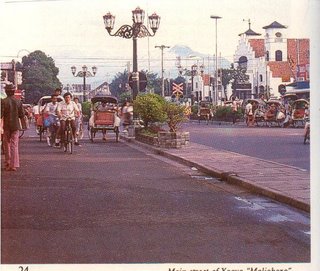 e brief period of British rule at the begining of the nineteenth century. In the daytime the streets is lined with colourful market stalls selling all kinds of local handicrafts. Here it is possible to have a rubber stamp made in a few hours, or purchase an oil to promote hair growth made from an extract of crushed scorpions. Competing with the street sellers are modern, glass fronted shops stocked with fashion goods, electronic gadgets, cassete tapes and quality batik. A night Malioboro transforms itself into what may be the world’s
e brief period of British rule at the begining of the nineteenth century. In the daytime the streets is lined with colourful market stalls selling all kinds of local handicrafts. Here it is possible to have a rubber stamp made in a few hours, or purchase an oil to promote hair growth made from an extract of crushed scorpions. Competing with the street sellers are modern, glass fronted shops stocked with fashion goods, electronic gadgets, cassete tapes and quality batik. A night Malioboro transforms itself into what may be the world’s
longest restaurant. A continuous row of food stalls extends down oth sides of the street, offering traditional delicacies like fried chicken or pigeon, and of course nasi gudeg, until well into the early hours of the morning. Entertainment is provided by a varety of artists and dtreet musicians, who help make every evening on Malioboro one of constant celebration.
PROMINENT BUILDING
Tugu Monument
Situated on the crossroads at the northern end of Jalan Mangkubumi, the Tugu monument was built on the order of Sultan Hamengku Buwono I in 1755 to mark the founding of the city of Yogyakarta. Originally 25 meters high, it collapsed during the eartquake of 1867 and was rebuilt 20 years later. The height of the present monument is less than half that of the original one.
Bank Negara Indonesia 1946
This elegant old building was designed by the Javanese architect R. Sindutomo in 1923. During World War II it was used by the occupying Japanese forces as their headquarters. Following the Japanese surrender it became the temporary location of the original Radio Republik Indonesia, before the Bank was founded in 1946. The building is situated at the southern end of Jalan Ahmad Yani, next to the Central Post Office.
Syuhada Mosque
Syuhada Mosque lies to the east of Jalan Mangkubumi, on the bank of the River Code. If’s large green dome can be seen from afar and forms a significant landmark. The mosque is situated in the area know as Kotabaru, where the streets are named after seventeen young citizens of Yogya who died fighting the Japanese in 1945.
Sasono Hinggil Dwi Abad
In former times, the Sultan’s of Yogyakarta used to watch military parades from this old building, which faces the southern Alun-Alun. Today it is a public building which stages regular all night performance of Wayang Kulit (see directory).
Margomulyo Congregation Reformed Church
This is the oldest church in the city and dates back to early Dutch colonial days. Located at 7 Jalan Ahmad Yani, the church was inaugurated and it’s first members baptised on 21st June 1830.
The Pakualam Palace
This is the residence of Prince Paku Alam VII, head of the junior line the Yogyakarta royal family. The Pakualam Principality was established in 1813 by Governor Raffles during the period of British rule in Java. The palace can be found on Jalan Sultan Agung. Although the building is not open to the staged on each Sunday Pon at the front reception hal (see calendar of events)
The Ambarrukmo Palace
This was originally the ‘country’ residence of Sultan Hamengku Buwono VII, whoretired here in 1921 after setting his son on the throne. Today it is the site of the four star Ambarrukmo Palace Hotel on Jalan Solo.
Fort Vredenburg
Situated on Jalan Ahmad Yani, this is an old Dutch fortrees dating from 1765. It is currently undergoing renovation by the Departement of Education and Culture and will eventually house a museum, art gallery and theatre for cultural performances.
The Beringharjo Market
Sultan Hamengku Buwono IX named this market Beringharjo after the forest area which was cleared for the purpose in 1756. Located on Jalan Ahmad Yani, the present building was constructed by the Dutch in 1925, though the remains of earlier Chinese werehaouses are still visibel on it’s northern side. Beringharjo stock an enormous range of merchandise, such as clothing, shoes, textiles, bags, baskets, mats, spices, foodstuffs, agricultural produce and household items. The narrow alley way running alongside the northern fence is a delight for those looking for unlikely articles. Here it is possible to find old bits of machinery, spare parts, second hand army boots, broken clocks, cameras and general scrap, among which may lie a few treasures.
Affandi Museum
The strange looking house on stills near the Ambarrukmo Hotel on Jalan Solo is studio of Affandi, Yogyakarta’s most famous painter. The roof is shaped like a banana leaf, which Affandi says was all that he had to shelter himself from the rain when he was still a poor young artist. Adjoining the studio is an exhibition hall displaying a permanent collection of his work, as well as tht of his daughter Kartika.
Kepatihan Danurejan
Once the official residence of the Patih Danurejo, the court administrator of the Sultanate when it still held power, the building now houese offices of Yogyakarta’s regional administration. It is situated on the eastern side of Jalan Malioboro.
Sasono Wirotomo
Sasono Wirotomo at Tegalrejo is the former residence of Prince Diponegoro, one of Indonesia’s culyure heroes. An heir to the Sultanate of Yogyakarta, the Prince led an uprising against the Dutch administration for five years between 1825 and 1830. He was eventually tricked into negotiations, arrested and exiled to Sulawesi where he died. Sasono Wirotomo houses a small museum containing Diponegoro’s keris and other possessions. Scratches on the arms of one of the chairs in the museum are said to have been caused by the Prince’s fingernails while he was trying to control his anger at having been deceived.
Founded in 1949, this is Indonesia’s most famous university. The campus covers an area of almost two square kilometres on the northern side of the city and consists of 18 departements registering close to 20,000 students from all over the country.
Plengkung Gading (The Arched Gate)
Plengkung Gading is the largest and most impressive of the remaining gateways which were originally set in the four kilometre stone wall surrounding the Kraton complex. Built after a European model, the gate once had a moat and a drawbridge, which have not survived. Another gate, called Plengkung Tarunosuro, is visible on the northern side of the palace. The eastern gate was rammed by British Sepoy Indian soldiers under Governor Raffles in 1812, after which the troops looted the Kraton and made off with seven million dollars worth of booty.
Hotel Garuda
The Garuda Hotel, at Malioboro 72, was originally built by the Dutch in 1909 and opened as the Grand Hotel. Recently renovated, the Garuda has the same kind of charm as hotels like the Raffles in Singapore, the Hotel Bali in Denpasar and the Dibya Puri in Semarang. A gamelan orachestra plays inthe reception hall daily.
OTHER PALACES
Imogiri – Graves of the Kings
Imogiri,wich lies about twenty kilo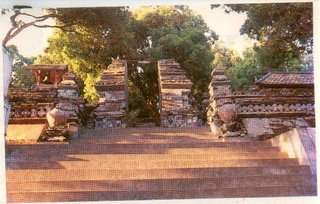 metres south of the city, is the site of the royal tombs of Mataram, Yogyakarta and Surakarta. It has a serene and peaceful atmosphere with many large, shady trees. The grave can be found on top of a hill, approached by 345 stone steps. Tradition has is that anyone who attempts to count the stept will al always arrive at a different result.
metres south of the city, is the site of the royal tombs of Mataram, Yogyakarta and Surakarta. It has a serene and peaceful atmosphere with many large, shady trees. The grave can be found on top of a hill, approached by 345 stone steps. Tradition has is that anyone who attempts to count the stept will al always arrive at a different result.
The tombs are divide into three main courtyards. The first, which occupies the centre of the complex, is the most important and contains the graves of Sultan Agung and the succeeding princes of Mataram. The other two, on either side of the central courtyard, are for the Susuhunans and Sultans of Solo and Yogya respectively.
Kotagede – Centre of Silver
The town of Kotagede, which lies about five kilometre south east of Yogyakarta, is best known today as a silverworking centre. The silversmiths who work here are descended from the original craftsmen who supplied the needs of the ancient court of Mataram in the sixteenth and seventeent centuries. The town was founded in the late 1500’s by Senopati, first Sultan of Sultan Agung, who moved the capital to nearby Karta. Although Senopati’s Kraton no longer exists, vicitors can still see his ‘throne’, which is a large black rock kept at the site of the original palace. Nearby is a royal cemetery, which was established by Sultan Hamengku Buwono VIII (921-1939). The tomb of Senopati himself can also be found at Kotagede. It attracts many visitors, who come to place offerings at the grave and ask for blessings.
Not far from the tomb is the site of the original mosque, which was rebuilt by Sultan Hamengku Buwono VI (1855-1877) and set in a high walld courtyard. Attendants dressed in traditional Javanese costume direct visitors to the various Places of historical interest and receive donations.
Gembira Loka – The Yogya Zoo
For those interested in wildlife, a wide variety of native Indonesian fauna can be viewed at the Gembira Loka Zoo. Among the animals kept there is a Sumatran tapir, an orang utan, a magnificent South American mandrill and a large number of bird, snakes and monkeys. In addition, the zoo contains some Komodo ‘dragons’ (varanus komodoensis) from eastern Indonesia. Measuring about 35 metres long and weighing close to 150 kg, the Komodo dragon in the worl’s largest carnivorous lizard. The reptiles are fed every five days in the late afternoons.
A large selection of native trees as well as an orchid nursey can be seen at Gembira Loka’s botanical garden. The Zoo is best avoided on Sundays, when it becomes very crowded.
Kaliurang and Mt Merapi
Kaliurang is a cool, hill resort which lies in the southern foothills of Mt Merapi, twenty five kilometres north of the city. For those wishing to escape the heat of the plains for a day or two the place is ideal. There are many small guest houses and losmen, which are empty all week but fill up at weekends and onholidays. Some of Yogyakarta ‘s wealthier citizens have bought holiday homes here and a few resident artists can be found in thevicinity. Kaliurang and it’s suroundings is also a good place to find exotic plants for sale. Ibu Thea’s horticulture service at Jalan Kaliurang Km 22,9 has probably the larget range avaiable in Yogyakarta. The popular place for foreign visitors is information for the serious traveller. Here you can find out where to stay in Singapore, eat in India, or just decide where togo next. The atmosphere at Vogels is pleaseant and relaxing and from here the visitor can enjoy exellent views of the Kewu plain to the south.
Kaliurang is one of the starting points for the ascent of Merapi, which is the most worthwhile climb in Central Java. While the approach to the summit from Selo on the northern side is serious and not without danger. Unless one is an experienced climber it is definitely advisable to hire a guide, since it is very easy to lose sense of direction onthe steep rocky face near the top.
Guides are available at the village of kinahrejo, which is about an hour’s walk from Kaliurang and is the usual ‘base camp’ for climbers. At Kinahrejo it is best to report to Mbah Marijan, the juru kunci, or ‘guardian of the mountain’, who can advise about prevailing weather conditions and current tactics required. Christian, the owner of Vogels, also gives helpful advice to those wishing to attempt the mountain. The view from the peak is well worth the effort. On a clear morning, after climbing through the night, the whole of Yogyakarta and Central Java stretches out below, from Mt Slamet in the west to Mt Lawu in the east. To the north the sea is sometimes visible.
About 27 kilometres south of Yogyakarta is a beach which is famed for it’s dunes of shifting grey s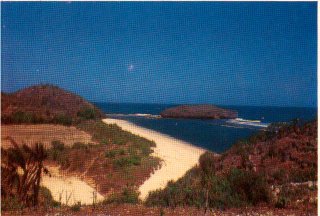 and. This is one of Yogyakarta’s mysical spots, where annual ceremonies are performed in honour of Nyai Roro Kidul, the goddess of the southern ocean. If a straight line is drawn from Parangtritis to Mt Merapi it will be found to pass directly through the centre of the Sultan’s Palace in Yogyakarta, indicating a spesial relationship between the mountain and the beach. While Parangtritis exhibits a strange beauty, the ocean is notoriously treacherous and great care must be taken when swiming here. According to local belief the goddess claimed numerous victims over the centuries and is particularly attracted by young men dressed in green.
and. This is one of Yogyakarta’s mysical spots, where annual ceremonies are performed in honour of Nyai Roro Kidul, the goddess of the southern ocean. If a straight line is drawn from Parangtritis to Mt Merapi it will be found to pass directly through the centre of the Sultan’s Palace in Yogyakarta, indicating a spesial relationship between the mountain and the beach. While Parangtritis exhibits a strange beauty, the ocean is notoriously treacherous and great care must be taken when swiming here. According to local belief the goddess claimed numerous victims over the centuries and is particularly attracted by young men dressed in green.

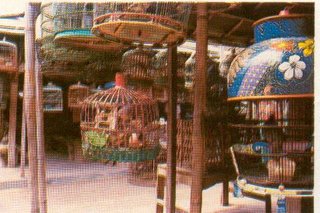
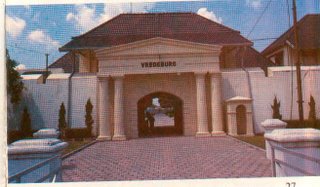




0 Comments:
Post a Comment
<< Home